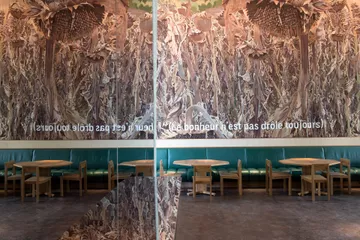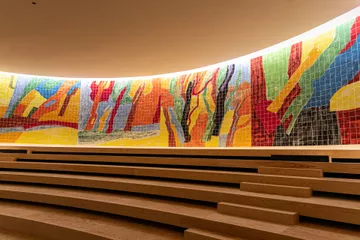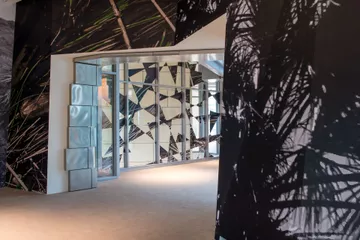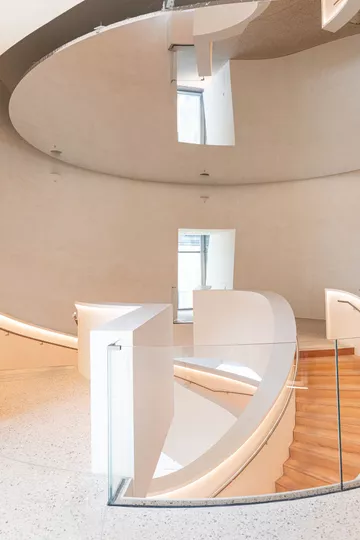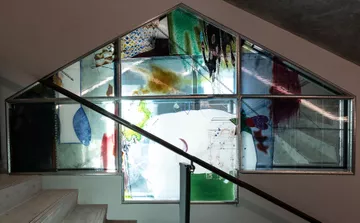
The Tower: Artists interventions
Rirkrit Tiravanija, Etel Adnan, Carsten Höller, Helen Marten, Liam Gillick, Ólafur Elíasson, Konstantin Grcic
Parc des Ateliers
The Tower
Starting from
These installations are freely accessible and do not require an admission ticket.
Drum Café
Rirkrit Tiravanija
The Tower / Ground Level
One of the key artists in the history of relational aesthetics, Tiravanija has designed and created one of the bars, located on the ground floor area of The Tower designed by Frank Gehry. The bar is designed as a lived-in artwork and includes the use of a huge array of material. Walls in stainless steel with exposed pipes and panels made from sunflower marrow: this restaurant and bar transforms the notion of hospitality with its very strong visual identity. Conviviality and sharing lies at the heart of Tiravanija’s practice and the bar and restaurant inevitably becomes one of the crucial representations of time spent with others.
The design is utilizing materials of the bioregion of the Camargue and natural resources, such as sunflower pulp, local wool, natural pigments and fabric dyes. A 10-metre long monumental tapestry created with artisans in Aubusson factory, central France, is the landmark of the space. It was made over many years and has used unique tapestry techniques and materials, in collaboration with designers and researchers from the labs of Atelier LUMA.
Dans la forêt
Etel Adnan
The Tower / Level 1 / Auditorium
Etel Adnan has created a unique artwork in the medium of ceramic wall mural covering the entire back wall of the auditorium at LUMA Arles. The mural is based on four of her drawings that represent the movement of trees in the wind, made in her trademark vibrant colours of orange, yellow, green and blue. These colours are characteristic of her late work using marker pen on paper.
Once the drawings were created, they have been reproduced in fired ceramic tiles and enlarged to cover a wall measuring approximately 14 metres in length and 4 metres in height. The drawings are specifically made for Arles and relate to both the impression of the wind in the South and to paintings of Van Gogh, who was also inspired by movement in nature, something he extensively represented throughout his life and work.
Isometric Slides
Carsten Höller
The Tower / Level 2
Carsten Höller has installed a new iteration of Slides, an experimental project he has been producing in different locations for a number of years. The artist is taking advantage of the height of the space to expand on the hypothesis he has been investigating for some time concerning the possible effects of sliding. His work, playful and evocative, questions what would be the effect and result of sliding if it was part of the daily routine. It asks whether slides, which are mostly associated with playgrounds, can become part of our experiential and architectural life. He has noted that "A slide is a sculpture that you can travel inside".
However, it would be a mistake to think that you have to use the slide to make sense of it. From an architectural and practical perspective, the slides are one of the building’s means of transporting people, equivalent to the escalators, lifts or stairs. Slides deliver people quickly, safely and elegantly to their destinations, they’re inexpensive to construct and energy-efficient. They’re also a device for experiencing an emotional state that is a unique condition, somewhere between delight and madness. It was described in the fifties by the French writer Roger Caillois as "a kind of voluptuous panic upon an otherwise lucid mind."
Laguna Gloria
Liam Gillick
The Tower / Level 2
Liam Gillick has designed the communal area in level 2 of The Tower. Using film stills from his 2013 film Margin Time 2 (The Heavenly Lagoon), he has created an audio-visual landscape and a space which will be used for multiple activities. The film stills present grainy images of plants and natural environments and the idea is to create a room that resembles an artificial garden. Playing with the idea of nature as a given, and space as an agent in the production of realities, the installation becomes an inverted pavilion, centrally located within The Tower where the public and audiences can rest or transit. The notion of impermanence and artificiality are the key components of the work, which is a system of images and sounds that is made to evoke a both distant and close relationship to nature.
Take your Time
Ólafur Elíasson
The Tower / Level 2
Take your Time is a large circular mirror fixed to the ceiling at an angle. The mirror rotates slowly on its axis, which creates a whirling sensation, destabilizing the viewer’s perception of space. The artwork is installed above the monumental, double-helix staircase, a position which adds a playful albeit disorienting effect as one arrives at its highest point. Engaging with the viewer’s movement, but also with light, reflection, and the elements of architecture and surrounding space, this work offers an enchanting experience. It is a new interpretation specifically created for the site of LUMA Arles.
Day Light Songs (biting the air)
Helen Marten
The Tower / Staircase Levels 7 to 9
Day Light Songs (biting the air) is a site-specific installation for three of the publicly accessible and daily used sections of the security staircase of The Tower. Comprising layered glass works and aluminium frames, it is occupying 3 double-sided apertures. Day Light Songs (biting the air) is neither painting nor stained-glass window, but a hybrid of the two. Produced as acts of literal liquid alchemy, the process included multiple ancient and contemporary techniques, such as, acid etching, fusing, enamelling, sand blasting, silver staining, silk screening and hand painting.
The profile of a child’s head dominates, sitting both centrally and at rising or sinking points around the aluminium frames. Within the silhouette is the word ‘mama’. The child’s central head becomes part of an alphabet, a shape that might be representative of a series of spoken sounds, or single letters from which a set of actions can unfold. These views shift, depending on whether the viewer is climbing or descending the doubled-sided staircase. A series of graphic vector forms, interposed between several sets of fences can just as equally be signs or diagrams or they can be portraits. Suspended, this morphing system of vantage points and characters, mixes with the textures of glass and milled metal details to add more units of measure, each relentlessly collaged into one another. This series of hybrid forms is deviced to morph and flex with incoming light. It becomes a quiet parable of the exponential powers of the universe to shrink and expand before us, a complex mathematical equation of many interconnected pieces.
Open Space
Konstantin Grcic
The Tower / Floor 8th and 9th
This unique space for multipurpose usage, devised as an extension of the street, was designed by German industrial designer Konstantin Grcic, renowned for his radical and minimalist interpretations of everyday objects.
The two floors - 8th is an interior space and 9th is leading to the Viewing Terrace - are conceptually connected and the design follows seamlessly between the two. Grcic has created a theatrical space, using metal curtains and special lights to subdivide areas.
Reflecting on a street-like concept, the designer has created spaces that are raw but hospitable with a sensitivity to the industrial nature of the building and its metal surfaces. The two floors benefit of the most commanding views extending towards the Camargue and the Alpilles, taking in the entire city of Arles, and offering perspectives never seen before of the historical city, the surrounding nature, and the landscape.
Artists biographies
Rirkrit Tiravanija
Since the 1990s, Rirkrit Tiravanija (b. 1961, Buenos Aires, Argentina) has aligned his artistic production with an ethic of social engagement, often inviting viewers to inhabit and activate his work. Solo exhibitions include the ICA London (permanent installation), Hirschhorn Museum and Sculpture Garden, Smithsonian, Washington D.C. (2019), the National Gallery of Singapore (2018), Stedelijk Museum, Amsterdam (2016), the Garage Museum of Contemporary Art, Moscow (2015), the Kunsthalle Bielefeld (2010), the Kunsthalle Fridericianum, Kassel (2009), the Musée d’Art Moderne de la Ville de Paris, the Guggenheim Museum, New York, the Serpentine Gallery in London (2005), as well as the Museum Boijmans Van Beuningen in Rotterdam (2004). Tiravanija’s work has been recognized with numerous awards and grants including the 2010 Absolut Art Award, the 2004 Hugo Boss Prize awarded by the Guggenheim Museum, and the 2003 Smithsonian American Art Museum’s Lucelia Artist Award.
Tiravanija lives and works in New York, Berlin, and Chiang Mai. Tiravanija is on the faculty of the School of Visual Arts at Columbia University, and is a founding member and curator of Utopia Station, a collective project of artists, art historians, and curators. Tiravanija is also President of an educational-ecological project known as The Land Foundation, located in Chiang Mai, Thailand, and is part of a collective alternative space called VER in Bangkok.
Etel Adnan
Etel Adnan (1925-2021) was a Lebanese-American artist, poet and essayist, writing in French and English. Born in Beirut, she moved to Paris after a long period of residence in California.
She began painting in the 1960s and her work has received international recognition since dOCUMENTA(13), in 2012. In 2014, she was invited to the biennial of the Whitney Museum (New York) and the Qatar museum of modern art, the Mathaf, dedicated a retrospective to her, organized by Hans Ulrich Obrist. Since then, numerous museums (Bern, Luxembourg, San Francisco, Aspen, Lille, etc.) and art centres have devoted exhibitions to her. Adnan’s works appear in numerous collections, including the MNAM-Center Pompidou, Paris; Mathaf, Doha, Qatar; MoMA, New York; M +, Hong Kong; Royal Jordanian Museum, Amman; the Museum of Modern Art, Tunis; Sursock Museum, Beirut; Institute of the Arab World, Paris; British Museum, London; Tate Gallery, London; World Bank Collection, Washington D.C.; National Museum for Women in the Arts, Washington D.C; as well as in many private collections.
Carsten Höller
Carsten Höller uses his training as a scientist in his work as an artist, concentrating particularly on the nature of human relationships. Born in Brussels in 1961, he now lives and works in Stockholm, Sweden and Biriwa, Ghana. His major installations include Test Site, a series of giant slides for Tate Modern’s Turbine Hall (2006), Amusement Park, an installation of full-size funfair rides turning and moving at very slow speed at MASS MoCA, North Adams, USA (2006), Flying Machine (1996), a work which hoists the viewer through the air, Upside-Down Goggles, an experiment with goggles which modify vision, and the famous The Double Club (2008-2009) in London, which opened in November 2008 and closed in July 2009, that took the form of a bar, restaurant and nightclub designed to create a dialogue between Congolese and Western culture.
His Revolving Hotel Room (2008), a rotating art installation that becomes a fully operational hotel room at night, was shown as part of theanyspacewhatever exhibition at the Guggenheim Museum in 2009. For his 2015 exhibition Decision at the Hayward Gallery, he turned the whole building into an experimental parcours with two entrances and four exits, two of them being slides. His works have been shown internationally over the last two decades, including solo exhibitions at Fondazione Prada, Milan (2000), the ICA Boston (2003), Musée d’Art Contemporain, Marseille (2004), Kunsthaus Bregenz, Austria (2008), Museum Boijmans Van Beuningen, Rotterdam (2010), Hamburger Bahnhof, Museum für Gegenwart, Berlin (2011), New Museum, New York (2011) Thyssen-Bornemisza Art Contemporary (TBA21), Vienna (2014), Pirelli HangarBicocca, Milan (2016), Henie Onstad Kunstsenter, Høvikodden, Norway (2017), The Florence Experiment at the Palazzo Strozzi, Florence (2018), Sunday at Museo Tamayo, Mexico City (2019) and most recently the exhibitions Behaviour at Kunsten Museum of Modern Art, Aalborg (2019) and Reproduction at Copenhagen Contemporary, Copenhagen (2019).
Liam Gillick
Liam Gillick deploys multiple forms to expose the new ideological control systems that emerged at the beginning of the 1990s. Gillick’s work ranges from small books to large-scale architectural collaborations. His practice exists in a constant tension between his formally minimalistic works that reflect upon the language of renovated space and his critical approach through writing and the use of text.
This approach is brought together in a continual testing of the conventions of the exhibition as form. In addition, he has produced a number of short films since the late 2000s, which address the construction of the creative persona in the light of the enduring mutability of the contemporary artist as a cultural figure. Throughout this time, Gillick has extended his practice into experimental venues and collaborative projects with artists, including Philippe Parreno, Lawrence Weiner and Louise Lawler.
Ólafur Elíasson
Visual artist Ólafur Elíasson (b.1967) grew up in Iceland and Denmark. In 1995,
he founded Studio Ólafur Elíasson in Berlin, which today comprises a team of craftsmen, architects, archivists, researchers, administrators, cooks, art historians, and specialised technicians. Natural phenomena—such as water, light, ice, fog, and reflections—feature prominently in Elíasson’s often-large-scale artworks. Ólafur Elíasson’s art is driven by his interests in perception movement embodied experience and feelings of self. He strives to make the concerns of art relevant to society at large. Art for him is a crucial means for turning thinking into doing in the world. Elíasson’s works span from sculpture to painting, photography, film and installation. Not limited to the confines of the museum and gallery his practice engages the broader public sphere through architectural projects interventions in civic space arts education policy-making and addressing the issues of sustainability and the climate crisis.
He is internationally renowned for works like The weather project (2003), an indoor sun shrouded in mist installed in the Turbine Hall at Tate Modern, London and seen by more than two million people, and his public art project The New York City Waterfalls (2008), a commission by the Public Art Fund with the support of former mayor Michael Bloomberg for which he installed four artificial waterfalls along Manhattan and Brooklyn shorelines in New York. Another acclaimed project in public space is Ice Watch, a public installation for which Elíasson and geologist Minik Rosing transported 12 massive blocks of glacial ice from Greenland to Copenhagen’s City Hall Square (2014) to coincide with the Fifth Assessment Report of the UN Intergovernmental Panel on Climate Change. The project was reiterated in Paris (2015) and London (2018). In 2012, he founded the social business, Little Sun, and in 2014, he and Sebastian Behmann founded Studio Other Spaces, an office for art and architecture.
Helen Marten
Helen Marten studied at Central Saint Martins, University of the Arts, London and Ruskin School of Fine Art, University of Oxford (2005-2008). In 2016 she was awarded the Turner Prize. Marten works across sculpture, painting, video and writing to create a body of work that questions the stability of the material world and our place within it. Alluding to ideas, systems and experiences, her work across all media sets out to articulate complex ideas about the way in which we exist in and understand the world around us. Marten assigns central importance to physical reality and craftsmanship. In her selection of materials, she explores the questions as to how expectation translate into material language - how material could be used for its specific location for a new narrative, or which materials can be associated with which characteristics, and correspondingly, already “belong” to a fixed set of associations.
Konstantin Grcic
Konstantin Grcic (born in 1965) was trained as a cabinet maker at The John Makepeace School for Craftsmen in Wood before studying Design at the Royal College of Art in London. Since setting up his own practice in 1991 he has developed furniture, products and lighting for leading design companies. Today, Konstantin Grcic Design is based in Berlin and is active in several fields ranging from industrial design projects, exhibition design and collaborations in architecture and fashion.
Among his producers are Artek, Authentics, Cassina, ClassiCon, Flos, Flötotto, Kettal, Laufen, Magis, Mattiazzi, Muji, Mutina, Nespresso, Plank, Serafino Zani and Vitra. From the fashion and lifestyle sector, Audi, Hugo Boss, Issey Miyake, Louis Vuitton, Prada, Rado and smart/Daimler are some of his clients.
Many of his products have been awarded international design prizes. He received the Compasso d'Oro in 2001 for the Mayday lamp (Flos), 2011 for the Myto chair (Plank) and 2016 for the OK lamp (Flos). For Tom and Jerry from Magis' series The Wild Bunch he received the German Design Award in Gold in 2011.
Grcic defines function in human terms, combining formal strictness with considerable mental acuity and humour. His work is characterised by careful research into the history of art, design and architecture and his passion for technology and materials.
